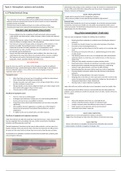Topic 6- Atmospheric systems and societies Deforestation and burning can also contribute to smog. The forest fires of Southeast Asia in
the late 1990s and in 2012-2014 produced the Asian ‘brown haze’, throughout much of
Malaysia, Indonesia and Singapore.
6.3 Photochemical Smog
QUICK CHECK QUESTIONS
-Explain what is meant by the term temperature inversion.
SIGNIFICANT IDEAS -Why is ozone a problem in areas experiencing atmospheric high pressure?
-The combustion of fossil fuels produces primary pollutants that may generate secondary
pollutants and lead to photochemical smog, the levels of which can vary by topography, Economic losses
population density and climate Economic losses include the cost of clean-up strategies, loss of tourism, decreased worker
-Photochemical smog has significant impacts on societies and living systems productivity, increased cost of health care, decreased crop productivity and the cost of
-Photochemical smog can be reduced by decreasing human reliance on fossil fuels replacing materials. The World Bank indicated that the cost of air pollution in China is worth
approximately 4% of its GDP annually.
PRIMARY AND SECONDARY POLLUTANTS
POLLUTION MANAGEMENT STARTAGIES
Primary pollutants from the combustion of fossil fuels include carbon monoxide,
carbon dioxide, soot (black carbon), oxides of nitrogen, oxides of sulfur and unburned There are many management strategies for tackling urban air pollution:
hydrocarbons.
Photochemical smog is a mixture of about 100 primary or secondary pollutants formed Reducing fossil fuel combustion is an effective way of limiting the release of
under the influence of sunlight. Ozone is the main pollutant. pollutants.
Fossil fuels are burned and nitrogen oxides are released in vehicle emissions. In the Increased use of public transport can reduce total emissions of fossil fuels.
presence of sunlight, these pollutants interact with others (e.g. volatile organic Promotion of clean technology/hybrid cars.
compounds) to produce secondary pollutants such as (tropospheric) ozone. Provision of park-and-ride schemes to limit the number of cars entering urban
Ozone formation can take a number of hours, hence the polluted air may have drifted areas.
into suburban and surrounding areas. Preventing cars from parts of the city, i.e. pedestrianizing part of the center
Smog is more likely under high-pressure (calm) conditions. Rain cleans the air and (Curitiba, Brazil)
winds disperse the smog- these effects are associated with low- pressure conditions. Only allowing certain cars into a city- for example those with odd-numbered
The frequency and severity of photochemical smog in an area depend on local registration plates on certain days, even numbered ones on other days (e.g.
topography, climate, population density and fossil fuel use. Mexico City)
Fitting cars with catalytic converters to reduce emissions of NOx
KEY DEFINITIONS
Reducing fossil fuel combustion by switching to renewable energy methods
Smog- the term now used for any haziness in the atmosphere caused by air pollutants. Reducing fossil fuel combustion through urban design (e.g. south-facing
Photochemical smog is produced through the effect of ultraviolet light on the products of windows, triple- glazed windows, and cavity and loft insulation).
internal combustion engines. It may contain ozone and is damaging to the human Relocating industries and power stations away from centers of population.
respiratory system and eyes. Ensuring industries and power stations have tall chimneys to help disperse
pollutants.
Tropospheric ozone Filtering and catching pollutants at the point of emission
Designing cities so that there are more open spaces and water courses to help
When fossil fuels are burned, two of the pollutants emitted are hydrocarbons
reduce the temperature and allow evaporative cooling (e.g. the restoration of
(from unburned fuel) and nitrogen monoxide (NO) Cheong-Gye-Cheon River in Seoul, South Korea).
Nitrogen monoxide reacts with oxygen to form nitrogen dioxide (NO 2), a brown Wearing masks to reduce inhalation of pollutants.
gas that contributes to urban haze.
Nitrogen dioxide can also absorb sunlight and break up to release oxygen atoms Larger cities with more vehicles will produce more tropospheric ozone than smaller cities.
that combine with oxygen in the air to form ozone
The main source of NOx is road transport. Areas suffering the worst effects f ozone are not necessarily the areas that produce the
pollution- ozone- polluted air can drift into suburban areas as it takes a number of hours to
The effects of tropospheric ozone form in sunlight.
Ozone is a toxic gas an oxidizing agent However:
It damages crops and forests, irritates eyes, can cause breathing difficulties in
humans and may increase susceptibility to infection Most urban pollution comes from cars, especially old cars
Ground-level ozone reduces plant photosynthesis and can reduce crop yields Vehicles using diesel produce emissions or particulate matter
significantly Catalytic convertors reduce fuel efficiency and increase CO2 emissions
Ozone pollution has been suggested as a possible cause of the dieback of Public transport can be expensive and may be inconvenient
German forests (previously it was believed these had died as a result of Sustainable urban design is expensive
acidification).
It is highly reactive and can attack fabrics and rubber materials
QUICK CHECK QUESTIONS
The effects of topography and temperature inversions -Suggest how cars can be prevented from entering a city centre
-Suggest how urban design can help reduce the incidence of photochemical smogs
Urban microclimates also affect the production of ground level ozone. Urban areas generally
have less vegetation than surrounding rural areas, and the concentration of buildings,
EXAM PRSCTISE
industries and offices generates much heat.
-Discuss, with reference to examples, the human factors that affect the successful
Thermal (temperature) inversions trap the smog in valley and basin- as in the cases of Los implementation of pollution management strategies. (6m)
Angeles, Santiago, Mexico City, Rio de Jeneiro, Sao Paulo and mountains and hills prevents
the warm air from rising. Cold air is denser than war air and so traps the warm air below.
Concentration of air pollutants can build to harmful and even lethal levels, producing toxic
and carcinogenic chemicals.





